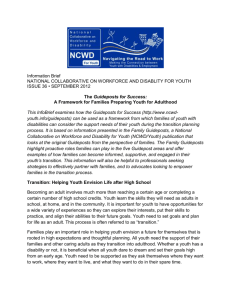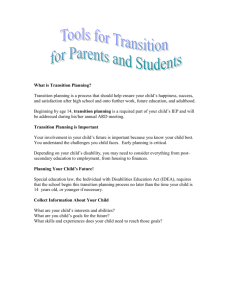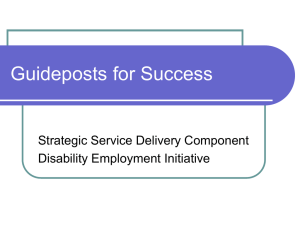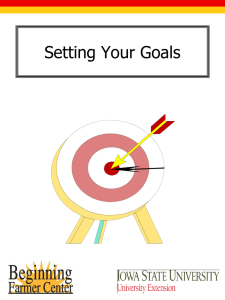Info B Guideposts for Success:
advertisement
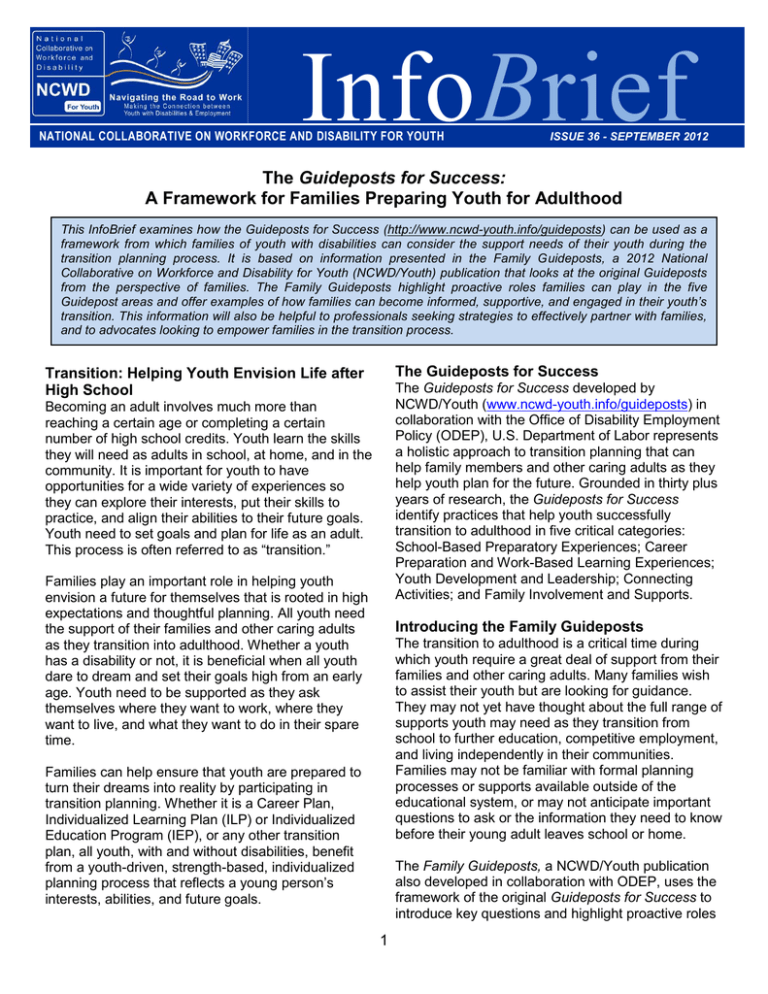
InfoBrief NATIONAL COLLABORATIVE ON WORKFORCE AND DISABILITY FOR YOUTH ISSUE 36 - SEPTEMBER 2012 The Guideposts for Success: A Framework for Families Preparing Youth for Adulthood This InfoBrief examines how the Guideposts for Success (http://www.ncwd-youth.info/guideposts) can be used as a framework from which families of youth with disabilities can consider the support needs of their youth during the transition planning process. It is based on information presented in the Family Guideposts, a 2012 National Collaborative on Workforce and Disability for Youth (NCWD/Youth) publication that looks at the original Guideposts from the perspective of families. The Family Guideposts highlight proactive roles families can play in the five Guidepost areas and offer examples of how families can become informed, supportive, and engaged in their youth’s transition. This information will also be helpful to professionals seeking strategies to effectively partner with families, and to advocates looking to empower families in the transition process. The Guideposts for Success Transition: Helping Youth Envision Life after High School The Guideposts for Success developed by NCWD/Youth (www.ncwd-youth.info/guideposts) in collaboration with the Office of Disability Employment Policy (ODEP), U.S. Department of Labor represents a holistic approach to transition planning that can help family members and other caring adults as they help youth plan for the future. Grounded in thirty plus years of research, the Guideposts for Success identify practices that help youth successfully transition to adulthood in five critical categories: School-Based Preparatory Experiences; Career Preparation and Work-Based Learning Experiences; Youth Development and Leadership; Connecting Activities; and Family Involvement and Supports. Becoming an adult involves much more than reaching a certain age or completing a certain number of high school credits. Youth learn the skills they will need as adults in school, at home, and in the community. It is important for youth to have opportunities for a wide variety of experiences so they can explore their interests, put their skills to practice, and align their abilities to their future goals. Youth need to set goals and plan for life as an adult. This process is often referred to as “transition.” Families play an important role in helping youth envision a future for themselves that is rooted in high expectations and thoughtful planning. All youth need the support of their families and other caring adults as they transition into adulthood. Whether a youth has a disability or not, it is beneficial when all youth dare to dream and set their goals high from an early age. Youth need to be supported as they ask themselves where they want to work, where they want to live, and what they want to do in their spare time. Introducing the Family Guideposts The transition to adulthood is a critical time during which youth require a great deal of support from their families and other caring adults. Many families wish to assist their youth but are looking for guidance. They may not yet have thought about the full range of supports youth may need as they transition from school to further education, competitive employment, and living independently in their communities. Families may not be familiar with formal planning processes or supports available outside of the educational system, or may not anticipate important questions to ask or the information they need to know before their young adult leaves school or home. Families can help ensure that youth are prepared to turn their dreams into reality by participating in transition planning. Whether it is a Career Plan, Individualized Learning Plan (ILP) or Individualized Education Program (IEP), or any other transition plan, all youth, with and without disabilities, benefit from a youth-driven, strength-based, individualized planning process that reflects a young person’s interests, abilities, and future goals. The Family Guideposts, a NCWD/Youth publication also developed in collaboration with ODEP, uses the framework of the original Guideposts for Success to introduce key questions and highlight proactive roles 1 The Guideposts for Success: A Framework for Families Preparing Youth for Adulthood for families in the five Guidepost areas. After considering the support needs of youth within each of these categories, families can decide where to focus their energy and take specific actions to address the priorities of their transition-age youth. Depending on the individual, these priorities might include graduating from high school, going to college, finding a job, building a circle of friends, actively participating in their communities, or connecting to the adult healthcare system. need to succeed in a specific area and then additional supports that may be needed by youth with disabilities, recommendations for families first address what families of all youth can do to help youth succeed and then provide recommendations specific to families of youth with disabilities. Starting with Families and Guidepost 5: Family Involvement and Supports Families are the first, most knowledgeable, and most consistent influence a youth will have. The contributions that families make are so important to the future success of youth that “Family Involvement and Supports” is one of the five original Guidepost areas. Both the Family Guideposts and this InfoBrief provide key questions that would be helpful for families to consider related to each Guidepost category, then suggest “Action Recommendations” that families can utilize so their youth’s transition needs are met. Like the Guideposts which first identify what all youth GUIDEPOST 5: FAMILY INVOLVEMENT AND SUPPORTS Participation and involvement of parents, family members, and/or other caring adults promotes the social, emotional, physical, academic, and occupational growth of youth, leading to better post-school outcomes. All youth need parents, families, and other caring adults who do the following: • have high expectations that build upon the young person’s strengths, interests, and needs and that foster each youth’s ability to achieve independence and self-sufficiency; • remain involved in their lives and assist them toward adulthood; • help youth access information about employment, further education, and community resources; • take an active role in transition planning with schools and community partners; and • have access to medical, professional, and peer support networks. In addition, youth with disabilities need parents, families, and other caring adults who have the following: • an understanding of the youth’s disability and how it may affect his or her education, employment, and daily living options; • knowledge of rights and responsibilities under various disability-related legislation; • knowledge of and access to programs, services, supports, and accommodations available for young people with disabilities; and • an understanding of how individualized planning tools can assist youth in achieving transition goals and objectives. Families are in a unique position to teach youth needed social skills and work skills and to instill a sense of determination and high expectations that goals can be achieved, whether a disability is present or not. For a youth, “family” may mean a traditional family, households led by single parents, grandparents, or relatives, being involved in foster care, or living in a group home. Whatever the situation, youth benefit from families who become well informed about education, employment, youth development, and supports available in the community. Informed families are better prepared to help youth understand options and make responsible decisions about their own lives. Here’s a closer look at how families can play a positive role in the youth transition to adulthood. 2 The Guideposts for Success: A Framework for Families Preparing Youth for Adulthood and internships, recognizing that school guidance counselors may or may not have the capacity to provide individualized support. Families can utilize tools such as Individualized Learning Plans that map a path to achieve post-school goals, college, and careers. How can families influence and support their youth as they transition into adulthood? Action Recommendations for families of ALL youth: Maintain high expectations that youth will succeed in school, employment, and as members of their community. Convey these expectations to educators, to service providers and to the youth themselves. Low expectations are often cited as contributing to limited educational and employment outcomes. In contrast, high family expectations are associated with improved achievement in these areas, as well as increased resiliency in youth. Help youth access networks of personal and professional contacts that they can utilize when needed as adults. Adolescence is the perfect time to begin building these networks since they still have families to support them if needed. Encourage youth to initiate contact with adults in their family and community networks to learn about their career paths and to seek supportive peer networks that result in lasting friendships. Remain involved in the life of youth, especially during the teenage years. Teens often seek opportunities for independence and peer approval, which may seem to lessen the influence families can play. However, research indicates that if families stay engaged in young people’s educational, social, and community activities, those youth are more likely to complete high school and avoid negative choices such as irresponsible sexual involvement, substance abuse, and illegal activity. As youth are developing their own identities and direction, it is important for families to stay connected and engaged with them. Action Recommendations for families of youth with disabilities: Understand the impact of disability and help youth to be able to discuss the lifelong implications of their own disability. Unfortunately, youth often have little information about their disabilities and may have families who think it is better not to speak openly about it. It is much more beneficial for families to share information about a disability as soon as the youth is ready for such conversations. This is an important step towards assisting a youth in taking charge of his/her own healthcare, education, and accommodation decisions. Help youth access information about employment, postsecondary education and training, and community services needed so they can make informed decisions about their own future. Families can guide their youth through the information seeking process, and in doing so, build skills so youth can eventually manage their own needs. This skill is especially important when considering the fast-changing nature of employment career paths and financial rules and regulations. Learn about disability rights and responsibilities to prepare for the shift in roles when a youth becomes his/her own legal guardian. Under federal special education law (Individuals with Disabilities Education Act or IDEA), youth who reach the Age of Majority (typically age 18) have the right to make their own educational decisions, unless their parents have legal guardianship. Families need to understand this shift in responsibilities and gradually pass responsibilities to youth over a period of time. Doing so will help youth apply their decision making skills while families are available to provide support and encouragement. Youth who have been actively Take an active role in transition planning so youth can be supported in decision making around academics, career exploration, employment, and postsecondary education. Family members can help youth explore activities such as career interest assessments, field trips to job sites, job shadowing, 3 The Guideposts for Success: A Framework for Families Preparing Youth for Adulthood involved in their own IEP from an early age will find this shift easier to handle. It would also benefit families to be aware that adult services for persons with disabilities often come with specific rules on eligibility and are not entitlements. Families who understand adult services and relevant legislation are better positioned to help their youth access services that can help them reach their own employment and independent living goals. Understand individualized planning tools, the role they play in transition planning, and how education and adult supports use such tools. Individualization is a fundamental tenant of most education and disability services, and there are many tools used to achieve this goal. For example, youth receiving special education services will have an IEP, which will drive instruction and supports based on individual needs. Adult service agencies may have similar “plans” based on individual assessments, strengths, and needs. It is crucial that families partner with schools and adult service agencies to make sure these planning tools reflect a youth’s goals and reflect the knowledge families have about youth and what they need to succeed in adulthood. Learn how to access services so youth have the supports and accommodations needed for their own growth and success. Knowing how to access these services is key as youth with disabilities transition from school to employment; in other words, youth move from a world of entitlement (e.g., Section 504 plan and IEP) to eligibility (ADA). There is a wide variety of services and supports available to address needs around employment, postsecondary education, transportation, housing, and other areas. Families can guide their youth through the information seeking process, and in doing so, build skills so youth can eventually manage their own services. Parents can seek help in understanding and connecting to resources by contacting their state’s Parent Center (www.parentcenternetwork.org), Center for Independent Living (www.ilru.org/html/publications/directory/index.html, or a community-based disability advocacy agency. These basic strategies provide a critical foundation for parents, family members, and other caring adults committed to supporting the social, emotional, physical, academic, and occupational growth of youth. References National Collaborative on Workforce and Disability for Youth. (2005). Guideposts for Success. Washington, D.C.: Institute for Educational Leadership. Online at http://www.ncwd-youth.info/guideposts. The National Collaborative on Workforce and Disability for Youth (NCWD/Youth) is composed of partners with expertise in disability, education, employment, and workforce development issues. NCWD/Youth is housed at the Institute for Educational Leadership in Washington, DC. The Collaborative is charged with assisting state and local workforce development systems to integrate youth with disabilities into their service strategies. This Information Brief was written by The PACER Center. To obtain this publication in an alternate format please contact the Collaborative at 877-871-0744 toll free or email contact@ncwd-youth.info. This Information Brief is part of a series of publications and newsletters prepared by the NCWD/Youth. All publications will be posted on the NCWD/Youth website at www.ncwd-youth.info. Please visit our site to sign up to be notified of future publications. This document was developed by the National Collaborative on Workforce and Disability for Youth, funded by a grant/contract/cooperative agreement from the U.S. Department of Labor, Office of Disability Employment Policy (Number #OD16519-07-75-4-11). The opinions expressed herein do not necessarily reflect the position or policy of the U.S. Department of Labor. Nor does mention of trade names, commercial products, or organizations imply the endorsement by the U.S. Department of Labor. Individuals may produce any part of this document. Please credit the source and support of federal funds. NCWD/Youth 1-877-871-0744 (toll-free) 1-877-871-0665 (TTY toll-free) http://www.ncwd-youth.info contact@ncwd-youth.info 4
